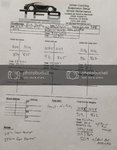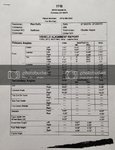DGRacing
Darren
Gasp!! What??? Preloading a swaybar?? You're not supposed to do that!!!
Yes, that is usually what is recommended but hear me out (this is a pet theory I want some feedback on).
So maybe some of you notice this, but since I'm a big fella I notice it a lot. My car turns left much more balanced and planted than it does right.
Not that its bad turning right at all, but at the limit there is more tire slip in the front than i care for.
Now this is primarily a result of the driver weight on the left side of the car. Oddly enough I turned my best lap with a full tank of gas and was only 1 second shy of that with pufferfish in the passenger seat. So I do believe performance favors balance over weight up to a point.
But I want my cake and eat it too. So here is my theory.
If I pre-load the front sway bar, it simulates weight on a given side of the car, offsetting the driver side weight difference. I've never tried this or done it before, so two questions.
1) Which side do I pre-load and how? I _think_ I need to add length to the endlinks on the driver side. Not 100% sure
2) What are the anticipated effects on left turns if I pre-load to distribute weight towards the right? more or less understeer?
That is all. Appreciate any input.
Darren
EDIT: I suppose the best thing to do is corner balance the car with my weight in the driver seat and adjust the sway bar until the cross weight is 50%. lol. Well, your input is still appreciated!
Yes, that is usually what is recommended but hear me out (this is a pet theory I want some feedback on).
So maybe some of you notice this, but since I'm a big fella I notice it a lot. My car turns left much more balanced and planted than it does right.
Not that its bad turning right at all, but at the limit there is more tire slip in the front than i care for.
Now this is primarily a result of the driver weight on the left side of the car. Oddly enough I turned my best lap with a full tank of gas and was only 1 second shy of that with pufferfish in the passenger seat. So I do believe performance favors balance over weight up to a point.
But I want my cake and eat it too. So here is my theory.
If I pre-load the front sway bar, it simulates weight on a given side of the car, offsetting the driver side weight difference. I've never tried this or done it before, so two questions.
1) Which side do I pre-load and how? I _think_ I need to add length to the endlinks on the driver side. Not 100% sure
2) What are the anticipated effects on left turns if I pre-load to distribute weight towards the right? more or less understeer?
That is all. Appreciate any input.
Darren
EDIT: I suppose the best thing to do is corner balance the car with my weight in the driver seat and adjust the sway bar until the cross weight is 50%. lol. Well, your input is still appreciated!















